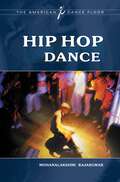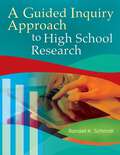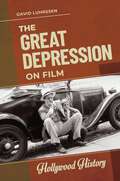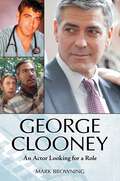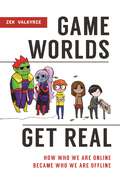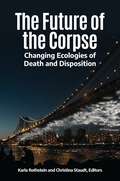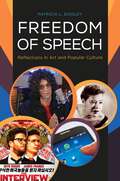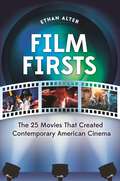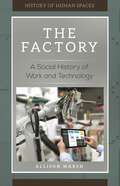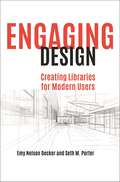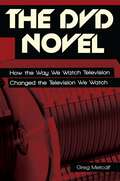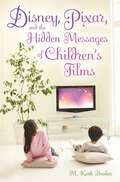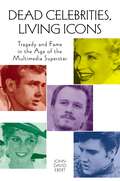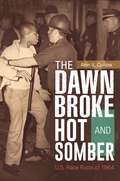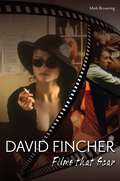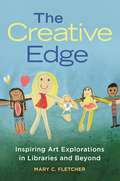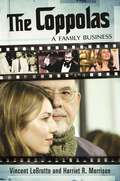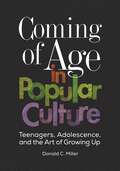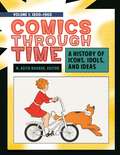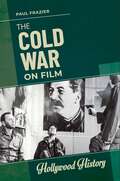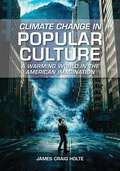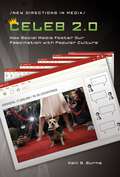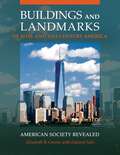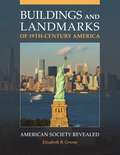- Table View
- List View
Hip Hop Dance (The American Dance Floor)
by Mohanalakshmi RajakumarThis guide provides an overview of the history of hip hop culture and an exploration of its dance style, appropriate both for student research projects and general interest reading.Rapping. Breakdancing. MCing. DJing. Beatboxing. Graffiti art. These are just some of the most well-known artistic expressions spawned from hip hop culture, which has grown from being an isolated inner-city subculture in the 1970s to being a truly international and mainstream culture that has taken root in countries as diverse as Japan, France, Israel, Poland, Brazil, South Korea, and England.This insightful book provides not only an overview of hip hop's distinctive dance style and steps, but also a historic overview of hip hop's roots as an urban expression of being left out of the mainstream pop culture, clarifying the social context of hip hop culture before it became a widespread suburban phenomenon. Hip Hop Dance documents all the forms of street music that led to one of the most groundbreaking, expressive, and influential dance styles ever created.
A Guided Inquiry Approach to High School Research (Libraries Unlimited Guided Inquiry)
by Randell K. SchmidtThis book helps educators foster academic success and college readiness: it demonstrates how to instruct high school students to find, process, and think about new information, and then synthesize that knowledge.When students are able to manage topics of high interest by choosing their own subject matter, they learn how to effectively perform pre-collegiate research through a process that they find fun and rewarding. Ideal for high school-level teachers and school librarians, this book provides a unique, holistic approach to guided inquiry that guides students step-by-step through the cognitive, affective, and social processes involved, building critical study skills, time management strategies, collaboration techniques, and communication and presentation skills.A Guided Inquiry Approach to High School Research is derived from a formal research protocol and provides proven techniques and supporting materials that facilitate the process for permitting students to choose their own topic, easily grasping how to search for information, and successfully completing a seemingly daunting research assignment—a process that makes understandings deep and integrative. The included detailed project lessons, student handouts, and rubrics and assessment tools are the result of many years of classroom testing and refinement.
The Great Depression on Film (Hollywood History)
by David LuhrssenThis book presents the Great Depression through the lens of 13 films, beginning with movies made during the Depression and ending with films from the 21st century, and encourages readers to examine the various depictions of this period throughout history.The Great Depression on Film is a unique guide to how the Great Depression was represented and is remembered, making it an excellent resource for students or anyone interested in film history or U.S. history. Each film is set in a different sector of American life, focusing on such topics as white supremacy, political protest, segregation, environmental degradation, crime, religion, the class system, and popular culture in the U.S. during the 1930s.This book is indispensable for clearing away misconceptions fostered by the movies while acknowledging the power of film in shaping public memory. The book separates fact from fiction, detailing where the movies are accurate and where they depart from reality, and places them in the larger context of historical and social events. Eyewitness or journalistic accounts are referenced and quoted in the text to help readers differentiate between ideas, attitudes, and events presented in the films, as well as the historical facts which inspired those films.
Global Pandemic Threats: A Reference Handbook (Contemporary World Issues)
by Michael C. LeMayThis book offers an accessible reference on epidemic and pandemic diseases that provides background information and history, explains why pandemics are a newly emerging threat, identifies the difficulties in coping with them, and provides hope in the form of modern medicine.Global Pandemic Threats: A Reference Handbook provides all-encompassing coverage that introduces key concepts and traces the history of pandemics, enabling readers to grasp the complexity of the global problem and the difficulties of executing effective solutions. Written in an easy-to-understand manner, it provides a "go-to" resource that systematically addresses dozens of diseases of the past as well as re-emergent or newly emerging pathogens that have the potential of becoming pandemics.The book's extensive coverage of past pandemics includes bubonic plague, cholera, influenza, measles, smallpox, tuberculosis, typhoid fever, and yellow fever, and the re-emergence of malaria, measles, pertussis (whooping cough), poliomyelitis, and other contagious diseases. It discusses a broad range of newly emerging viral threats, such as AIDS/HIV, avian flu, anthrax, botulism, Ebola, E. coli, Gulf War syndrome, hanta virus, Lassa virus, Lyme disease, Marburg virus, MERS, MRSA, Ricin, Sin Nombre virus (SNV), and West Nile virus. The work offers perspectives from individuals interested and involved in the fight, including medical professionals and health care workers; profiles of key organizations and persons; a helpful timeline of past and present pandemic outbreaks; and a glossary of key terms and concepts.
George Clooney: An Actor Looking for a Role
by Mark BrowningThis book traces the evolution of George Clooney's successful career, from his humble start as a television heartthrob to his current position as one of the most powerful figures in film making today.It can be said that George Clooney has crafted his artistic brand through a mixture of smart career choices of roles, carefully nuanced performances, and key relationships with directors. He is not just an accomplished actor but a major Hollywood player, serving as director, producer, and writer on many projects. His work garners critical acclaim, and his influence and creative input have been the main reason why some of his films exist at all. This fascinating book analyzes the impressive career trajectory of one of the industry's most powerful figures today.George Clooney: An Actor Looking for a Role is the first book to examine the full range of Clooney's career. Arranged by genre, sections include early television work, romantic comedies, action films, heist movies, political thrillers, and films that blend a number of different genres. Clooney's contributions have not only resulted in three Oscar acting nominations and one win, but his work continues to challenge the conventions of the traditional form and expands the definition of key genres.
Game Worlds Get Real: How Who We Are Online Became Who We Are Offline
by Zek ValkyrieThis book explores how after 20 years of existence, virtual world games have evolved: the social landscapes within digital worlds have become rigid and commodified, and "play" and "fun" have become rational and mechanical products.Twenty million people worldwide play Massively Multi-Player Online Role Playing Games (MMORPGs). Online role-playing gaming is no longer an activity of a tiny niche community. World of Warcraft—the most popular game within the genre—is more than a decade old. As technology has advanced and MMORPGs became exponentially more popular, gaming culture has evolved dramatically over the last 20 years. Game Worlds Get Real: How Who We Are Online Became Who We Are Offline presents a compelling insider's examination of how adventuring through virtual worlds has transformed the meaning of play for millions of gamers.The book provides a historical review of earlier incarnations of virtual world games and culture in the late 1990s, covering the early years of popular games like EverQuest, to the soaring popularity of World of Warcraft, to the current era of the genre and its more general gaming climate. Author Zek Valkyrie—a researcher in the areas of gaming culture, digital communities, gender, sexualities, and visual sociology as well as an avid gamer himself—explores the evolution of the meaning of "play" in the virtual game world, explains how changes in game design have reduced opportunities for social experimentation, and identifies how player types such as the gender switcher, the cybersexual, the explorer, and the trial-and-error player have been left behind in the interest of social and informational transparency.
The Future of the Corpse: Changing Ecologies of Death and Disposition
by Karla Rothstein and Christina StaudtThis book reviews the spectrum of death, from when the living person turns to corpse until the person lives in the memory of mourners, and its impact on the ecology of the socio-cultural community and physical environment.This book demonstrates that American society today is in a pivotal period for re-imaging end-of-life care, funerary services, human disposition methods, memorializing, and mourning. The editors and contributors outline the past, present, and future of death care rituals, pointing to promising new practices and innovative projects that show how we can better integrate the dying and dead with the living and create positive change that supports sustainable stewardship of our environment. Individual chapters describe prevailing practices and issues in different settings where people die and in postmortem rituals; disposition and current ecologically and, in urban areas, spatially unsustainable methods; law of human remains; customs and trends among key stakeholders, such as cemeteries and funeral directors; and relevant technological advances. The book culminates in a presentation of emerging sustainable disposition technologies and innovative designs for proposed public memorial projects that respond to shifting values, beliefs, and priorities among an increasingly diverse population.
Freedom of Speech: Reflections in Art and Popular Culture (Issues through Pop Culture)
by Patricia L. DooleyThis book examines how freedom of speech is reflected in pop culture by looking at numerous examples of films, websites, television shows, and songs that have touched on—and impacted—this issue.It is easy to overlook the importance of freedom of speech in our modern world, where it often seems "anything goes." In actuality, freedom of speech issues are still highly relevant in the 21st century, even if our cultural and social contexts now allow many forms of expression that were unacceptable in previous eras. This book focuses on how freedom of speech is reflected in pop culture by looking at the films, websites, television shows, and songs that have touched on—and impacted—this issue. It examines specific examples of freedom of speech issues within everything from print media to music, theater, photography, film, television, sports, video games, and social media and demonstrates that pop culture sometimes contributes to the expansion of freedom of speech.
Film Firsts: The 25 Movies That Created Contemporary American Cinema
by Ethan AlterThis forward-looking exploration of contemporary American film across the last 40 years identifies and examines the specific movies that changed the film industry and shaped its present and future.Since the mid-1970s, American cinema has gone through enormous changes, such as the birth of the modern summer blockbuster, the rise of the independent film industry, ongoing technological advancements in special effects, and the ever-evolving models for film distribution. Written by a professional film critic and film buff, this book tells the story of contemporary American cinema in a unique and engaging way: by examining 25 key movies that demonstrated a significant creative, technological, or business innovation that impacted the industry at large.Each chapter in this chronological survey of contemporary film is divided into two sections: "The Film," which offers a critical overview of the film in question; and "The First," which describes the specific innovation achieved by that film and places that achievement in the larger historical context. Two additional appendices in each chapter explore other significant aspects of both the film and its groundbreaking nature. The broad coverage—ranging from action movies to horror films to science fiction favorites—ensures the work's appeal to all film fans.
The Factory: A Social History of Work and Technology (History of Human Spaces)
by Allison MarshThe book goes beyond the assembly line to examine the physical environment of the industrial landscape.What machines are used to make cars and computer chips? Who are the people who make the products? When did robots replace humans on the assembly line? Why are factories configured the way they are? The Factory: A Social History of Work and Technology answers these questions and more, offering readers a behind-the-scenes look into the wonders of mass production. The book traces the history of the factory from the first small cottage workshop through the Industrial Revolution to the large, clean room it is today. It also examines the people behind the machines and how their roles have been defined by the design of factory buildings. Lastly, it illustrates the broader world of industrialization in relation to the effects it has had on workers and the consumer society that feeds it.
Engaging Design: Creating Libraries for Modern Users
by Emy Nelson Decker Seth M. PorterThis book demonstrates how aesthetics, design elements, and visual literacy can be implemented in the library to enhance spaces, programs, services, instruction, and outreach so that your library will appeal to all users.Libraries have come to accept that they must rethink how they appeal to users, and harnessing the power of design can be a powerful means for addressing the changing needs of the community. Decker and Porter introduce "engaging design"—an umbrella term that incorporates multiple design frameworks with a focus on a three-prong approach: aesthetics, design thinking, and service design. These frameworks can be used to guide design choices that will aid in teaching and engaging current and potential library users.In the course of a lively and interesting narrative, Engaging Design introduces basic concepts of aesthetics and good design and explores examples of its successful uses in the academic, public, and special library. It provides simple steps for implementing subtle, but powerful, techniques to improve instruction, human-computer interaction, e-learning, public services spaces, wayfinding signage, and all manner of library programs, events, and services. In addition, the authors recommend easy-to-implement best practices that will help librarians to enhance library-goers' experience. Library administrators will also look to this book for assistance in best addressing the needs of the modern library user.
The DVD Novel: How the Way We Watch Television Changed the Television We Watch
by Greg MetcalfNow that television shows can live forever as DVD sets, the stories they can tell have changed; television episodes are now crafted as chapters in a season-long novel instead of free-standing stories. This book examines how this significant shift in storytelling occurred.In 1981, NBC's Hill Street Blues combined the cop show and the soap opera to set the model for primetime serial storytelling, which is evident in The Sopranos, The Wire, and Breaking Bad. In 1963, ABC's The Fugitive showed how an anthology series could tell a continuing tale, influencing The X-Files, House, and Fringe. In 1987, NBC's The Days and Nights of Molly Dodd changed the situation comedy into attitudinal comedy, leading to Weeds, Nurse Jackie, and Entourage. The DVD Novel: How the Way We Watch Television Changed the Television We Watch not only examines how American television shows changed, but also what television artists have been able to create.The book provides an alternate history of American television that compares it to British television, and explains the influence of Dennis Potter's The Singing Detective on the development of long-form television and the evolution of drama shows and sitcoms. The work considers a wide range of network and cable television shows, paying special attention to the work of Steven Bochco, David Milch, and David Simon, and spotlighting the influence of graphic novels and literary novels in changing television.
Disney, Pixar, and the Hidden Messages of Children's Films
by Prof. M. Keith BookerThis work is a wide-ranging survey of American children's film that provides detailed analysis of the political implications of these films, as well as a discussion of how movies intended for children have come to be so persistently charged with meaning.Disney, Pixar, and the Hidden Messages of Children's Films provides wide-ranging scrutiny of one of the most lucrative American entertainment genres. Beyond entertaining children—and parents—and ringing up merchandise sales, are these films attempting to shape the political views of young viewers? M. Keith Booker examines this question with a close reading of dozens of films from Disney, Pixar, Dreamworks, and other studios, debunking some out-there claims—The Ant Bully communist propaganda?—while seriously considering the political content of each film.Disney, Pixar, and the Hidden Messages of Children's Films recaps the entire history of movies for young viewers—from Snow White and the Seven Dwarfs to this year's Up—then focuses on the extraordinary output of children's films in the last two decades. What Booker finds is that by and large, their lessons are decidedly, comfortably mainstream and any political subtext more often than not is inadvertent. Booker also offers some advice to parents for helping children read films in a more sophisticated way.
Dead Celebrities, Living Icons: Tragedy and Fame in the Age of the Multimedia Superstar
by John David EbertThis in-depth series of literary portraits studies celebrities who died in famous and tragic ways—ways that still resonate as archetypal death scenarios in present day.We know their likes and dislikes, admire their talents, envy them for daring to be what we can't or what we won't. When they are snatched from us, we feel a personal loss and an unwillingness to let go. And so we transform these mere human beings into icons whose stars often shine in death even more brilliantly than in life.Dead Celebrities, Living Icons: Tragedy and Fame in the Age of the Multimedia Superstar explores this phenomenon through a series of essays on 14 men and women who are, arguably, the most famous people of the 20th and early 21st centuries. The book covers the epoch of the celebrity beginning in the 1930s with Howard Hughes and Walt Disney and continues to the present day with the life and death of Michael Jackson. Far more than just a collection of biographies, Dead Celebrities, Living Icons documents the philosophical importance and significance of the contemporary cult of the celebrity and analyzes the tragic consequences of a human life lived in the glare of the media spotlight.
The Dawn Broke Hot and Somber: U.S. Race Riots of 1964
by Ann V. CollinsWhat were the socioeconomic conditions and factors that resulted in riots erupting in northern U.S. cities in 1964? This book examines the year in American history that brought a new era in race relations to the nation.As the end of the second decade of the 21st century approaches, America seems on the verge of widespread civil unrest due to what is perceived to be consistent injustices against people of color, both in terms of lack of opportunity to improve their socioeconomic status and their treatment at the hands of law enforcement. Similar race-based resentment and anger swept the nation half a century ago. Can the United States avoid a repeat of the past?The Dawn Broke Hot and Somber: U.S. Race Riots of 1964 fills a crucial gap in racial collective violence literature, examining the changing nature of riots in the United States and identifying the conditions and factors that led to the anger and frustration that resulted in riots in July and August of 1964. Through its careful evaluation of specific riots in New York, New Jersey, Illinois, and Pennsylvania, this book shows how cultural and economic changes intersected with political circumstances to shape human actions. Readers will understand the effects that the riots had on the major political and economic issues of 1964, such as the implementation of the Civil Rights Act and the War on Poverty as well as the events of and the outcome of the presidential election between Lyndon Johnson and Barry Goldwater. The book also analyzes the actions taken by local, state, and federal officials to try to understand and quell the violence and considers the racial unrest that followed these riots in the later years of the 1960s and beyond.
David Fincher: Films That Scar
by Mark BrowningFilm scholar Mark Browning offers the first detailed analysis of the work of David Fincher, director of the critically acclaimed films Se7en, Fight Club, and The Curious Case of Benjamin Button.David Fincher is one of the most exciting filmmakers working in Hollywood today. He has produced a string of groundbreaking films that have achieved both critical and commercial success, while constantly challenging audiences to rethink their expectations of generic boundaries. David Fincher: Films That Scar is the first truly analytical work on the films of this mysterious and complex filmmaker. This insightful book analyzes all of Fincher's feature films, as well as examples of his commercials and pop videos, tracing key influences that include his background in special effects. It considers how he creates roles for strong women, how he has extended the detective genre, and how he adapts cult texts. The book also questions whether Fincher's films, famous for their downbeat endings and "dark" visual style, are really bleak or just part of an unconventional approach to filmmaking. In the end, readers will understand the development of Fincher's individual films and appreciate how the films relate closely to each other.
The Creative Edge: Inspiring Art Explorations in Libraries and Beyond
by Mary C. FletcherLibrary facilitators of art-based creativity sessions will learn how to choose materials and art experiences appropriate for young people from toddlers to teens and for intergenerational groups.In the modern world, innovative and creative individuals have a distinct advantage: the creative edge. The Creative Edge explains how you can design and conduct art-based creativity programming in your library. Written by a library creativity specialist, this book is the result of the author's many years of experience facilitating art groups for all ages. Her programs have achieved national recognition and will serve as a guide for others to establish art-based creativity sessions. In this book, she incorporates research that documents the importance of creativity as an essential component of childhood development and connects it to library learning goals, including literacy.Creativity research can be applied in libraries and at other public institutions to develop programs that will meet the needs of the next generation. The book includes many practical elements, such as lists for recommended art materials, step-by-step instructions on setup and procedures, and ideas inspired by picture book illustrations that connect to story time themes. The Creative Edge teaches readers how to provide programs that promote child-led exploration, experiential learning, innovative thought, and creative confidence.
The Coppolas: A Family Business (Modern Filmmakers)
by Vincent LoBrutto Harriet R. LoBruttoThis fascinating, behind-the-scenes look at a Hollywood dynasty offers an in-depth study of the films and artistry of iconic director Francis Ford Coppola and his daughter, Sofia, exploring their work and their impact on each other, both personally and professionally.The Coppolas: A Family Business examines the lives, films, and relationship of two exemplary filmmakers, Francis Ford Coppola and his daughter Sofia. It looks at their commonalities and differences, as artists and people, and at the way those qualities are reflected in their work.Much of the book is devoted to Francis and his outstanding achievements—and equally notable failures—as a screenwriter, director, producer, and presenter of landmark works of cinema. The narrative goes beyond the heyday of his involvement with Hollywood to analyze his more recent projects and the choices that led him to create small, independent films. In Sofia's case, the story is one of women's growing independence in the arts, revealing how Sofia developed her craft to become a cinematic force in her own right. In addition to its insightful commentary on their contributions to cinema past and present, the volume provides intriguing hints at what fans might anticipate in the future as both Coppolas continue to expand their artistry.
Coming of Age in Popular Culture: Teenagers, Adolescence, and the Art of Growing Up
by Donald C. MillerDocumenting the evolution of teens and media from the 1950s through 2010, this book examines the films, books, television shows, and musical artists that impacted American culture and shaped the "coming of age" experience for each generation.The teenage years are fraught with drama and emotional ups and downs, coinciding with bewildering new social situations and sexual tension. For these reasons, pop culture and media have repeatedly created entertainment that depicts, celebrates, or lampoons coming of age experiences, through sitcoms like The Wonder Years to the brat pack films of the 1980s to the teen-centered television series of today. Coming of Age in Popular Culture: Teenagers, Adolescence, and the Art of Growing Up covers a breadth of media presentations of the transition from childhood to adulthood from the 1950s to the year 2010. It explores the ways that adolescence is characterized in pop culture by drawing on these representations, shows how powerful media and entertainment are in establishing societal norms, and considers how American society views and values adolescence. Topics addressed include race relations, gender roles, religion, and sexual identity. Young adult readers will come away with a heightened sense of media literacy through the examination of a topic that inherently interests them.
Comics through Time [4 volumes]: A History of Icons, Idols, and Ideas [4 volumes]
by M. Keith BookerFocusing especially on American comic books and graphic novels from the 1930s to the present, this massive four-volume work provides a colorful yet authoritative source on the entire history of the comics medium.Comics and graphic novels have recently become big business, serving as the inspiration for blockbuster Hollywood movies such as the Iron Man series of films and the hit television drama The Walking Dead. But comics have been popular throughout the 20th century despite the significant effects of the restrictions of the Comics Code in place from the 1950s through 1970s, which prohibited the depiction of zombies and use of the word "horror," among many other rules. Comics through Time: A History of Icons, Idols, and Ideas provides students and general readers a one-stop resource for researching topics, genres, works, and artists of comic books, comic strips, and graphic novels. The comprehensive and broad coverage of this set is organized chronologically by volume. Volume 1 covers 1960 and earlier; Volume 2 covers 1960–1980; Volume 3 covers 1980–1995; and Volume 4 covers 1995 to the present. The chronological divisions give readers a sense of the evolution of comics within the larger contexts of American culture and history. The alphabetically arranged entries in each volume address topics such as comics publishing, characters, imprints, genres, themes, titles, artists, writers, and more. While special attention is paid to American comics, the entries also include coverage of British, Japanese, and European comics that have influenced illustrated storytelling of the United States or are of special interest to American readers.
The Cold War on Film (Hollywood History)
by Paul FrazierThe Cold War on Film illustrates how to use film as a teaching tool. It stands on its own as an account of both the war and the major films that have depicted it.Memories of the Cold War have often been shaped by the popular films that depict it—for example, The Manchurian Candidate, The Hunt for Red October, and Charlie Wilson's War, among others. The Cold War on Film examines how the Cold War has been portrayed through a selection of 10 iconic films that represent it through dramatization and storytelling, as opposed to through documentary footage.The book includes an introduction to the war's history and a timeline of events. Each of the 10 chapters that follow focuses on a specific Cold War film. Chapters offer a uniquely detailed level of historical context for the films, weighing their depiction of events against the historical record and evaluating how well or how poorly those films reflected the truth and shaped public memory and discourse over the war. A comprehensive annotated bibliography of print and electronic sources aids students and teachers in further research.
Climate Change in Popular Culture: A Warming World in the American Imagination
by James Craig HolteAn invaluable resource for general readers investigating climate change, this book examines the impact of climate change on popular culture and analyzes how writers and directors treat the disasters caused by climate change in their novels and films.Climate Change in Popular Culture: A Warming World in the American Imagination is the first study that includes analyses of both fiction and popular nonfiction works devoted to climate change. In addition, the book examines a number of classic works from the perspective of the growing field of climate change literature and includes a brief history of climate change science as well basic scientific definitions, all intended for general readers.The text provides an introduction to the science, politics, and economics of climate change. It also includes both historical overviews and potential probable futures projected by leading climate scientists and environmental writers. In addition, the text looks at how such creative writers and directors as Margaret Atwood, John Steinbeck, Paulo Bacigalupi, Kim Stanley Robinson, T. C. Boyle, Michael Crichton, and Octavia Butler, among others, have used the disasters caused by climate change in their work.
Celeb 2.0: How Social Media Foster Our Fascination with Popular Culture (New Directions in Media)
by Kelli S. BurnsThis volume looks at how the new capabilities of Web 2.0 are changing the worlds of celebrity fandom and gossip.With Ashton Kutcher's record-breaking "tweeting" more famous than his films, and Perez Hilton actually getting more attention than Paris, the actress often covered in his blog, the worlds of celebrity celebration and online social networking are pushing the public's crush on the famous and infamous into overdrive. Celeb 2.0: How Social Media Foster Our Fascination with Popular Culture explores this phenomenon.Celeb 2.0 looks at how blogs, video sharing sites, user-news sites, social networks, and message boards are fueling America's already voracious consumption of pop culture. Full of fascinating insights and interviews, the book looks at how celebrities use blogs, Twitter, and other tools, how YouTube and other sites create celebrity, how Web 2.0 shortens the distance between fans and stars, and how the new social media influences news reporting and series television.
Buildings and Landmarks of 20th- and 21st-Century America: American Society Revealed
by Elizabeth B. Greene Edward SaloThis engaging book uses buildings and structures as a lens through which to explore various strands of U.S. social history, revealing the connections between architecture and the cultural, economic, and political events before and during these American landmarks' construction.During the 20th and 21st centuries, the United States became the dominant world power. The tumultuous progression of our nation to global leader can be seen in the social, cultural, and political history of the United States over the last century, and the country's evolution is also reflected in major buildings and landmark sites across the nation. Buildings and Landmarks of 20th- and 21st-Century America: American Society Revealed documents how the construction, design, and function of famous buildings and structures can inform our understanding of societies of the past. Its text and images enable readers to get a deeper understanding of the buildings themselves as well as what happened at each structure's location and how those events fit into our nation's history. Through the study of specific buildings or types of buildings that influenced the cultural, social, and political history of the nation, readers will explore monuments to presidents, learn about how the first tract home neighborhoods came into existence, and marvel at the role of buildings in helping us get to the moon, just to mention a few topics.
Buildings and Landmarks of 19th-Century America: American Society Revealed
by Elizabeth B. GreeneAn invaluable resource for readers interested in architecture and design that demonstrates how the construction, form, and function of key structures in the 19th-century influenced American social, political, economic, and intellectual life.America has always been a nation of thinkers, believers, creators, and builders. Evidence of this is plentiful among the landmarks constructed in the 19th century. Buildings and Landmarks of 19th-Century America: American Society Revealed examines many examples that include homes, office buildings, recreational spaces, military sites, religious buildings, and other landmarks in a variety of geographical locations, discussing the background, architecture, and cultural significance of each. Each engaging, accessible entry not only provides readers detailed information about how the landmark relates to what was going on in American society at the time of its construction but also sparks the reader's interest to research the subject further.As examples, consider that a rural cemetery built in Massachusetts in the early 19th century was the prime influence on public park design and led to the construction of New York's Central Park and many other public parks since. The millionaire industrialist and philanthropist Andrew Carnegie built many of the first free public libraries in the country, which led to the development of municipal public library systems. The huge success of 19th-century world's fairs, like the 1876 Centennial Exhibition and the 1893 World's Columbian Exhibition, had lasting effects on society through the many new products that they introduced to the public. Throughout the book, landmarks are analyzed to elucidate their influence on many aspects of 19th-century society, including the treatment of the mentally ill, impact of religious revivals, growth of leisure and vacation time, and housing for the poor and the western homesteader, among many others.In the "How to Evaluate Buildings and Structures" section, readers are prompted to consider questions such as "What specific purposes did the building or structure have?" "When was it constructed, and what were the circumstances?" and "What was the need it addressed?" Students will learn about the period while also developing the skills of observation and assessment needed to analyze these landmarks and draw meaningful conclusions from them about their context and significance. The discussion of each landmark serves to help readers with these elements of critical thinking, assessment, and analysis.
